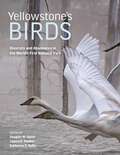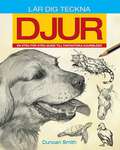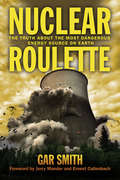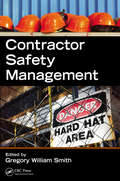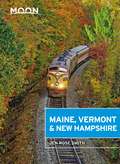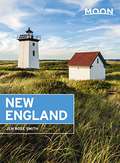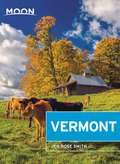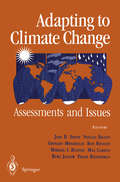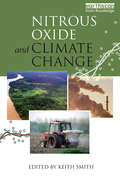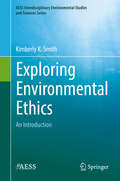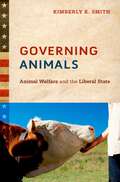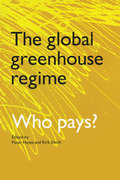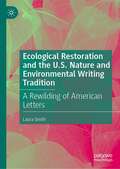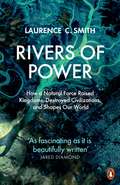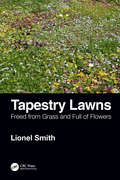- Table View
- List View
Yellowstone’s Birds: Diversity and Abundance in the World’s First National Park
by Douglas W. Smith Lauren E. Walker Katharine E. Duffy Robert K. LandisA beautifully illustrated survey of Yellowstone’s breathtaking birdlife, written by a team of renowned ornithologists and wildlife biologistsEstablished in 1872, Yellowstone National Park is the oldest and arguably the most famous national park in North America, attracting millions of visitors each year. While many come to the park for its recreational activities, the wildlife of Yellowstone is just as alluring. This book brings together more than 30 leading experts to provide the first comprehensive survey of the natural history, science, and conservation of birds in Yellowstone. Covering most bird species breeding within the great park as well as the many migrants that pass through, Yellowstone’s Birds is a scientific tour de force and an essential resource for visitors to Yellowstone and bird lovers everywhere.Tallies more than 200 species, including migrantsDescribes the natural history, status, and latest science on the birds of YellowstoneFeatures fact-filled, easy-to-read chapters, informative sidebar essays, maps, infographics, and photos that present current science in an easily understood wayAccompanied by videos by award-winning cinematographer Bob LandisDraws on a wealth of data on Yellowstone’s birds collected over many decadesWith contributions by many of today’s leading bird experts, this is a long-overdue survey of Yellowstone’s breathtaking avian fauna
The Fundamentals of Drawing Animals: A step-by-step guide to creating eye-catching artwork
by Duncan SmithFull of character and endlessly varied, our furry friends are great fun to draw. In this inspirational book, professional artist and animal-lover Duncan Smith shows how to create convincing drawings of a wide array of species, from domestic pets to farmyard animals, wild beasts and birds. Whether you are a complete novice or whether you want to take your animal portraits to the next level, The Fundamentals of Drawing Animals will show you how to get the most out of this enjoyable activity.
Lär Dig Teckna Djur: En steg-för-steg-guide till fantastiska djurbilder
by Duncan SmithDet är kul att teckna djur! Duncan Smith, konstnär och tecknare, visar hur man fångar karaktären, formen och strukturen hos en lång rad djur, alltifrån våra sällskapsdjur till bondgårdens djur, vilda djur och fåglar. Alla kan lära sig att teckna djur. Vare sig du är nybörjare eller enbart vill förbättra dina färdigheter i att teckna djurporträtt kommer Lär dig teckna djur att visa hur du får ut det mesta av denna givande hobby.
Nuclear Roulette: The Truth about the Most Dangerous Energy Source on Earth
by Gar Smith Ernest Callenbach Jerry ManderNuclear power is not clean, cheap, or safe. With Three Mile Island, Chernobyl, and Fukushima, the nuclear industry's record of catastrophic failures now averages one major disaster every decade. After three US-designed plants exploded in Japan, many countries moved to abandon reactors for renewables. In the United States, however, powerful corporations and a compliant government still defend nuclear power-while promising billion-dollar bailouts to operators. Each new disaster demonstrates that the nuclear industry and governments lie to "avoid panic," to preserve the myth of "safe, clean" nuclear power, and to sustain government subsidies. Tokyo and Washington both covered up Fukushima's radiation risks and-when confronted with damning evidence-simply raised the levels of "acceptable" risk to match the greater levels of exposure. Nuclear Roulette dismantles the core arguments behind the nuclear-industrial complex's "Nuclear Renaissance." While some critiques are familiar-nuclear power is too costly, too dangerous, and too unstable-others are surprising: Nuclear Roulette exposes historic links to nuclear weapons, impacts on Indigenous lands and lives, and the ways in which the Nuclear Regulatory Commission too often takes its lead from industry, rewriting rules to keep failing plants in compliance. Nuclear Roulette cites NRC records showing how corporations routinely defer maintenance and lists resulting "near-misses" in the US, which average more than one per month. Nuclear Roulette chronicles the problems of aging reactors, uncovers the costly challenge of decommissioning, explores the industry's greatest seismic risks-not on California's quake-prone coast but in the Midwest and Southeast-and explains how solar flares could black out power grids, causing the world's 400-plus reactors to self-destruct. This powerful exposé concludes with a roundup of proven and potential energy solutions that can replace nuclear technology with a "Renewable Renaissance," combined with conservation programs that can cleanse the air, and cool the planet.
Contractor Safety Management
by Gregory W. SmithA Winner of the Educational Award by the World Safety OrganizationContractor safety management is often seen as nothing more than a subset of general safety management in that no special consideration needs to be given to understanding the difficulties of the contract environment. This leaves contractors endlessly juggling competing and someti
Management Obligations for Health and Safety
by Gregory W. SmithIn recent years, the safety management field has placed leadership and commitment at the center of effective workplace health and safety programs. At the same time, personal liability for workplace health and safety has increased, resulting in poor outcomes for individual managers. Discussing the minimum expectations that courts and tribunals have
Routledge Handbook of Ocean Resources and Management (Routledge Environment and Sustainability Handbooks)
by Hance D. Smith Tundi S. Agardy Juan Luis Suárez de ViveroThis comprehensive handbook provides a global overview of ocean resources and management by focusing on critical issues relating to human development and the marine environment, their interrelationships as expressed through the uses of the sea as a resource, and the regional expression of these themes. The underlying approach is geographical, with prominence given to the biosphere, political arrangements and regional patterns – all considered to be especially crucial to the human understanding required for the use and management of the world's oceans. Part one addresses key themes in our knowledge of relationships between people and the sea on a global scale, including economic and political issues, and understanding and managing marine environments. Part two provides a systematic review of the uses of the sea, grouped into food, ocean space, materials and energy, and the sea as an environmental resource. Part three on the geography of the sea considers management strategies especially related to the state system, and regional management developments in both core economic regions and the developing periphery. Chapter 23 of this book is freely available as a downloadable Open Access PDF under a Creative Commons Attribution-Non Commercial-No Derivatives 3.0 license. https://www.routledgehandbooks.com/doi/10.4324/9780203115398.ch23
Routledge Handbook of Ocean Resources and Management (Routledge Environment and Sustainability Handbooks)
by Hance D. Smith Tundi S. Agardy Juan Luis Suárez De ViveroThis comprehensive handbook provides a global overview of ocean resources and management by focusing on critical issues relating to human development and the marine environment, their interrelationships as expressed through the uses of the sea as a resource, and the regional expression of these themes. The underlying approach is geographical, with prominence given to the biosphere, political arrangements and regional patterns – all considered to be especially crucial to the human understanding required for the use and management of the world's oceans. Part one addresses key themes in our knowledge of relationships between people and the sea on a global scale, including economic and political issues, and understanding and managing marine environments. Part two provides a systematic review of the uses of the sea, grouped into food, ocean space, materials and energy, and the sea as an environmental resource. Part three on the geography of the sea considers management strategies especially related to the state system, and regional management developments in both core economic regions and the developing periphery. Chapter 23 of this book is freely available as a downloadable Open Access PDF under a Creative Commons Attribution-Non Commercial-No Derivatives 3.0 license. https://www.routledgehandbooks.com/doi/10.4324/9780203115398.ch23
The Intrinsic Value of Endangered Species (Routledge Studies in Ethics and Moral Theory)
by Ian A. SmithWhy save endangered species without clear aesthetic, economic, or ecosystemic value? This book takes on this challenging question through an account of the intrinsic goods of species. Ian A. Smith argues that a species’ intrinsic value stems from its ability to flourish—its organisms continuing to reproduce successfully and it avoiding extinction—which helps to demonstrate a further claim, that humans ought to preserve species that we have endangered. He shows our need to exercise humility in our relations with endangered species through the preservation of their intrinsic goods, which in turn rectifies our degradation of their importance. Unique in its appeal to virtue ethics and to species concepts, The Intrinsic Value of Endangered Species is an important resource for scholars working in environmental ethics and the philosophy of biology.
The Intrinsic Value of Endangered Species (Routledge Studies in Ethics and Moral Theory)
by Ian A. SmithWhy save endangered species without clear aesthetic, economic, or ecosystemic value? This book takes on this challenging question through an account of the intrinsic goods of species. Ian A. Smith argues that a species’ intrinsic value stems from its ability to flourish—its organisms continuing to reproduce successfully and it avoiding extinction—which helps to demonstrate a further claim, that humans ought to preserve species that we have endangered. He shows our need to exercise humility in our relations with endangered species through the preservation of their intrinsic goods, which in turn rectifies our degradation of their importance. Unique in its appeal to virtue ethics and to species concepts, The Intrinsic Value of Endangered Species is an important resource for scholars working in environmental ethics and the philosophy of biology.
Moon Maine, Vermont & New Hampshire (Travel Guide)
by Jen Rose SmithWinter skiing, spring wildflowers, summertime beaches, or autumnal foliage: no matter the season, Moon Maine, Vermont & New Hampshire reveals the best of these New England gems. Inside you'll find:Strategic, flexible itineraries designed for outdoor adventurers, history buffs, foodies, and more, including a week-long road trip covering Maine, Vermont, and New Hampshire The top sights and unique experiences: See the fall foliage paint the landscape red and gold, and wander through a small-town harvest festival. Wade through tide pools in Acadia National Park, or hike the rocky landscapes of White Mountains. Sip your way through Burlington's breweries, or sample local flavors at the Brattleboro farmers market. Catch the sunrise at a picturesque lighthouse, relax on miles of sandy coastline, and line up with the locals for lobster rolls, fresh-shucked oysters, and fried clams. Go skiing in the Green Mountains, or cozy up for an old-fashioned sleigh ride through the snowHonest advice on when to go, where to stay, and how to get around from Vermont local Jen Rose SmithFull-color, vibrant photos and detailed maps throughoutThorough background on the wildlife, landscape, climate, and local cultureRecommendations for families, international visitors, travelers with disabilities, and moreWith Moon Maine, Vermont & New Hampshire's expert tips and local know-how, you can plan your trip your way.Hitting the road? Try Moon New England Road Trip.
Moon New England: Boston, Acadia National Park, White Mountains, Berkshires, Newport, And Cape Cod (Travel Guide)
by Jen Rose SmithExplore the best of New England's historic cities, admire the famed fall foliage, and stroll the stunning coastline with Moon New England. Inside you'll find:Flexible itineraries for every season, including quick weekend getaways from Boston and New York and two weeks exploring all of New EnglandStrategic advice for foliage-seekers, beach bums, winter sports enthusiasts, foodies, and moreCan't-miss highlights and unique experiences: Catch America's first sunrise at Acadia, or hike the rocky landscape of the White Mountain Peaks. Sample your way through craft breweries, or sip chowder in America's oldest restaurant. Explore rolling dunes and sandy beaches at Cape Cod, and find the best local seafood shack for lobster rolls, fresh-shucked oysters, and piles of fried clams. Follow in the footsteps of the founders on Boston's Freedom Trail, or gaze at glamorous 19th-century mansions in Newport. Hit the top slopes in the region for skiing and snowboarding, or watch the changing leaves paint the landscape in red and goldExpert advice from Vermont local Jen Rose Smith on when to go, where to stay, and how to get aroundFull-color photos and detailed regional and city maps throughoutThorough background on the wildlife, landscape, climate, and local cultureRecommendations for families with children, international visitors, seniors, travelers with disabilities, and moreFocused coverage of Boston, Cape Cod and the Islands, the Berkshires, Connecticut, Rhode Island, Vermont, New Hampshire's Seacoast and Lakes Region, New Hampshire's White Mountains, Coastal Maine, and Acadia National ParkWith Moon New England's practical tips and local know-how, you can plan your trip your way.Hitting the road? Try Moon New England Road Trip. Looking for more New England? Try Moon Boston or Moon Vermont.
Moon Vermont (Travel Guide)
by Jen Rose SmithFrom snowy resorts and fall foliage to maple syrup and artisanal cheese, get to know the Green Mountain State with Moon Vermont. Inside you'll find:Strategic, flexible itineraries like a week touring the food scene, the great outdoors, and the best of the state, with ideas for families, foodies, outdoor adventurers, and moreMust-see highlights and unique experiences: Wander through historic Montpelier, quirky Brattleboro, or charming Woodstock. Take a horse-drawn sleigh ride through fresh, fluffy snow, visit the woods that inspired Robert Frost, or stock up on flannels at an old-fashioned country store. Cruise the highway to see the stunning changing leaves, go cross-country skiing, hike a segment of the Long Trail, or cool off in a swimming hole. Dine at innovative restaurants serving forest-foraged cuisine and sample small-batch artisanal cheese, a flight of craft brews, and maple syrup Scenic drives in Vermont for viewing fall foliage, the best romantic getaways, and the top ski areas in the stateHonest recommendations from Vermont local Jen Rose Smith on when to go, where to eat, and where to stay, from budget campgrounds to historic bed-and-breakfastsFull-color photos and detailed maps throughoutAccurate, up-to-date information on the landscape, wildlife, and history Handy tips for international visitors, seniors, travelers with disabilities, and moreWith Moon Vermont's practical tips and local know-how, you can find your adventure.Expanding your trip? Try Moon Maine, Vermont & New Hampshire. Hitting the road? Check out Moon New England Road Trip.
Adapting to Climate Change: An International Perspective
by Joel B. Smith Neeloo Bhatti Gennady V. Menzhulin Ron Benioff Max Campos Bubu Jallow Frank Rijsberman Mikhail I. Budyko R. K. DixonGlobal climate change is one of the most important environmental issues facing the world today. The United Nations Framework Convention on Climate Change (FCCC) acknowledges the potential for global climate change to have major effects on the world economy. The work of the Intergovernmental Panel on Cli mate Change (lPCC) is focused on evaluating the scientific data on climate change and analyzing the potential responses to it. One of the primary issues in the global climate change debate is how to adapt to any change that might occur. The process ofidentifying adaptation measures and evaluating their effectiveness is the focus of this book. In dealing with climate change adaptation, the sequence of events in conduct ing these types of analyses can be generalized as follows: • Develop scenarios for the possible range of climate change, • Assess the vulnerability of various sectors of the national economy and infrastructure to climate change, and • Identify and evaluate measures in each sector to adapt to the climate change It is this third step that is the subject of this book. In presenting this material, Chapter 1 gives an overview of the concept of climate change adaptation and the general principles guiding the conduct of analyses in this area. Chapters 2-7 give the results of evaluating climate change adaptation options in the agriculture, water resources, coastal resources, forest and ecosystems, fisheries, and human settlements sectors.
Nitrous Oxide and Climate Change
by Keith SmithNitrous oxide, N2O, is the third most important (in global warming terms) of the greenhouse gases, after carbon dioxide and methane. As this book describes, although it only comprises 320 parts per billion of the earth's atmosphere, it has a so-called Global Warming Potential nearly 300 times greater than that of carbon dioxide. N2O emissions are difficult to estimate, because they are predominantly biogenic in origin. The N2O is formed in soils and oceans throughout the world, by the microbial processes of nitrification and denitrification, that utilise the reactive N compounds ammonium and nitrate, respectively. These forms of nitrogen are released during the natural biogeochemical nitrogen cycle, but are also released by human activity. In fact, the quantity of these compounds entering the biosphere has virtually doubled since the beginning of the industrial age, and this increase has been matched by a corresponding increase in N2O emissions. The largest source is now agriculture, driven mainly by the use of synthetic nitrogen fertilisers. The other major diffuse source derives from release of NOx into the atmosphere from fossil fuel combustion and biomass burning, as well as ammonia from livestock manure. Some N2O also comes directly from combustion, and from two processes in the chemical industry: the production of nitric acid, and the production of adipic acid, used in nylon manufacture. Action is being taken to curb the industrial point-source emissions of N2O, but measures to limit or reduce agricultural emissions are inherently more difficult to devise. As we enter an era in which measures are being explored to reduce fossil fuel use and/or capture or sequester the CO2 emissions from the fuel, it is likely that the relative importance of N2O in the 'Kyoto basket' of greenhouse gases will increase, because comparable mitigation measures for N2O are inherently more difficult, and because expansion of the land area devoted to crops, to feed the increasing global population and to accommodate the current development of biofuels, is likely to lead to an increase in N fertiliser use, and thus N2O emission, worldwide. The aim of this book is to provide a synthesis of scientific information on the primary sources and sinks of nitrous oxide and an assessment of likely trends in atmospheric concentrations over the next century and the potential for mitigation measures.
Nitrous Oxide and Climate Change
by Keith SmithNitrous oxide, N2O, is the third most important (in global warming terms) of the greenhouse gases, after carbon dioxide and methane. As this book describes, although it only comprises 320 parts per billion of the earth's atmosphere, it has a so-called Global Warming Potential nearly 300 times greater than that of carbon dioxide. N2O emissions are difficult to estimate, because they are predominantly biogenic in origin. The N2O is formed in soils and oceans throughout the world, by the microbial processes of nitrification and denitrification, that utilise the reactive N compounds ammonium and nitrate, respectively. These forms of nitrogen are released during the natural biogeochemical nitrogen cycle, but are also released by human activity. In fact, the quantity of these compounds entering the biosphere has virtually doubled since the beginning of the industrial age, and this increase has been matched by a corresponding increase in N2O emissions. The largest source is now agriculture, driven mainly by the use of synthetic nitrogen fertilisers. The other major diffuse source derives from release of NOx into the atmosphere from fossil fuel combustion and biomass burning, as well as ammonia from livestock manure. Some N2O also comes directly from combustion, and from two processes in the chemical industry: the production of nitric acid, and the production of adipic acid, used in nylon manufacture. Action is being taken to curb the industrial point-source emissions of N2O, but measures to limit or reduce agricultural emissions are inherently more difficult to devise. As we enter an era in which measures are being explored to reduce fossil fuel use and/or capture or sequester the CO2 emissions from the fuel, it is likely that the relative importance of N2O in the 'Kyoto basket' of greenhouse gases will increase, because comparable mitigation measures for N2O are inherently more difficult, and because expansion of the land area devoted to crops, to feed the increasing global population and to accommodate the current development of biofuels, is likely to lead to an increase in N fertiliser use, and thus N2O emission, worldwide. The aim of this book is to provide a synthesis of scientific information on the primary sources and sinks of nitrous oxide and an assessment of likely trends in atmospheric concentrations over the next century and the potential for mitigation measures.
The Way of the Hermit: My 40 years in the Scottish wilderness
by Ken SmithWaterstones Scottish Book of the Month'A love story to the mountains in the mist, the pulsating northern lights and the red deer at dawn. And to independence.' - The Washington Post'A Thoreauvian account of solitary life in the Scottish Highlands . . . delightful' - Kirkus Reviews'Ken Smith’s advice for staying alive in inclement conditions could equally be applied to achieving hard-won dreams' – Geographical'Ken Smith comes across as a thoughtful, resourceful and above all humane man . . . inspiring' – BBC Countryfile Magazine*****Could you leave behind the bustle of modern society and spend your days immersed in nature? In The Way of the Hermit, seventy-four-year-old Ken Smith recounts a life he has chosen to spend alone with the wilderness.Ken Smith has spent the past four decades in the Scottish Highlands. He lives alone, with no electricity or running water. His home is a log cabin nestled near Loch Treig, known as 'the lonely loch', where he lives off the land: he fishes for his supper, chops his own wood, and even brews his own tipple. He is, in the truest sense of the word, a hermit.For the first time, Ken shares the story of his life. From his working-class origins in Derbyshire, to the formative years he spent travelling in the Yukon and finally how he came to be the Hermit of Loch Treig. Looking back through decades of diary entries, Ken reflects upon the reasons he turned his back on society, the vulnerability of old age and the awe and wonder of a life lived in nature. The Way of the Hermit is a humorous, transcendent and life-affirming memoir.
Exploring Environmental Ethics: An Introduction (AESS Interdisciplinary Environmental Studies and Sciences Series)
by Kimberly K. SmithThis book is designed as a basic text for courses that are part of an interdisciplinary program in environmental studies. The intended reader is anyone who expects environmental stewardship to be an important part of his or her life, as a citizen, a policy maker, or an environmental management professional. In addition to discussing major issues in environmental ethics, it invites readers to think about how an ethicist's perspective differs from the perspectives encountered in other environmental studies courses. Additional topics covered include corporate social responsibility, ecological citizenship, property theory, and the concept of stewardship as a vocation.
Governing Animals: Animal Welfare and the Liberal State
by Kimberly K. SmithWhat is the role of government in protecting animal welfare? What principles should policy makers draw on as they try to balance animal welfare against human liberty? Much has been written in recent years on our moral duties towards animals, but scholars and activists alike have neglected the important question of how far the state may go to enforce those duties. Kimberly K. Smith fills that gap by exploring how liberal political principles apply to animal welfare policy. Focusing on animal welfare in the United States, Governing Animals begins with an account of the historical relationship between animals and the development of the American liberal welfare state. It then turns to the central theoretical argument: Some animals (most prominently pets and livestock) may be considered members of the liberal social contract. That conclusion justifies limited state intervention to defend their welfare - even when such intervention may harm human citizens. Taking the analysis further, the study examines whether citizens may enjoy property rights in animals, what those rights entail, how animals may be represented in our political and legal institutions, and what strategies for reform are most compatible with liberal principles. The book takes up several policy issues along the way, from public funding of animal rescue operations to the ethics of livestock production, animal sacrifice, and animal fighting. Beyond even these specific policy questions, this book asks what sort of liberalism is suitable for the challenges of the twenty-first century. Smith argues that investigating the political morality of our treatment of animals gives us insight into how to design practices and institutions that protect the most vulnerable members of our society, thus making of our shared world a more fitting home for both humans and the nonhumans to which we are so deeply connected.
Governing Animals: Animal Welfare and the Liberal State
by Kimberly K. SmithWhat is the role of government in protecting animal welfare? What principles should policy makers draw on as they try to balance animal welfare against human liberty? Much has been written in recent years on our moral duties towards animals, but scholars and activists alike have neglected the important question of how far the state may go to enforce those duties. Kimberly K. Smith fills that gap by exploring how liberal political principles apply to animal welfare policy. Focusing on animal welfare in the United States, Governing Animals begins with an account of the historical relationship between animals and the development of the American liberal welfare state. It then turns to the central theoretical argument: Some animals (most prominently pets and livestock) may be considered members of the liberal social contract. That conclusion justifies limited state intervention to defend their welfare - even when such intervention may harm human citizens. Taking the analysis further, the study examines whether citizens may enjoy property rights in animals, what those rights entail, how animals may be represented in our political and legal institutions, and what strategies for reform are most compatible with liberal principles. The book takes up several policy issues along the way, from public funding of animal rescue operations to the ethics of livestock production, animal sacrifice, and animal fighting. Beyond even these specific policy questions, this book asks what sort of liberalism is suitable for the challenges of the twenty-first century. Smith argues that investigating the political morality of our treatment of animals gives us insight into how to design practices and institutions that protect the most vulnerable members of our society, thus making of our shared world a more fitting home for both humans and the nonhumans to which we are so deeply connected.
The Global Greenhouse Regime: Who Pays?
by Kirk R. SmithEffective policies to prevent global warming and climatic change are urgently required by the world community. However, international negotiations on this issue repeatedly come up against the problems of allocating responsibility for the greenhouse effect, and bearing the costs of remedying the situation.;This volume offers a multidisciplinary response to the challenge. It presents the scientific, economic and political issues and goes on to describe the policy options available. The different ways of determining responsibility for greenhouse gases and calculating obligations to pay for hazards to the environment are analyzed. The contributors examine the implications for various countries, while a concluding chapter explores climatic change negotations - what is at stake, and for whom.
The Global Greenhouse Regime: Who Pays?
by Kirk R. SmithEffective policies to prevent global warming and climatic change are urgently required by the world community. However, international negotiations on this issue repeatedly come up against the problems of allocating responsibility for the greenhouse effect, and bearing the costs of remedying the situation.;This volume offers a multidisciplinary response to the challenge. It presents the scientific, economic and political issues and goes on to describe the policy options available. The different ways of determining responsibility for greenhouse gases and calculating obligations to pay for hazards to the environment are analyzed. The contributors examine the implications for various countries, while a concluding chapter explores climatic change negotations - what is at stake, and for whom.
Ecological Restoration and the U.S. Nature and Environmental Writing Tradition: A Rewilding of American Letters
by Laura SmithThis book presents a critical history of the intersections between American environmental literature and ecological restoration policy and practice. Through a storying—restorying—restoring framework, this book explores how entanglements between writers and places have produced literary interventions in restoration politics. The book considers the ways literary landscapes are politicized by writers themselves, and by conservationists, activists, policymakers, and others, in defense of U.S. public lands and the idea of wilderness. The book profiles five environmental writers and examines how their writings on nature, wildness, wilderness, conservation, preservation, and restoration have variously inspired and been translated into ecological restoration programs and campaigns by environmental organizations. The featured authors are Henry David Thoreau (1817–1862) at Walden Pond, John Muir (1838–1914) in Yosemite National Park, Aldo Leopold (1887–1948) at his family’s Wisconsin sand farm, Marjory Stoneman Douglas (1890–1998) in the Everglades, and Edward Abbey (1927–1989) in Glen Canyon. This book combines environmental history, literature, biography, philosophy, and politics in a commentary on considering (and developing) environmental literature’s place in conversations on restoration ecology, ecological restoration, and rewilding.
Rivers of Power: How a Natural Force Raised Kingdoms, Destroyed Civilizations, and Shapes Our World
by Laurence C. Smith'As fascinating as it is beautifully written' JARED DIAMOND, Pulitzer Prize-winning author of Guns, Germs and SteelRivers, more than any road, technology or political event, have shaped the course of civilization. Rivers have opened frontiers, defined borders, supported trade, generated energy and fed billions. Most of our greatest cities stand on river banks or deltas, and our quest for mastery has spurred staggering advances in engineering, science and law. Rivers and their topographic divides have shaped the territories of nations and the migration of peoples, and yet - as their resources become ever more precious - can foster cooperation even among enemy states. And even as they become increasingly domesticated, they remain a formidable global force: these vast arterial powers promote life but are capable of destroying everything in their path.From ancient Egypt to our growing contemporary metropolises, Rivers of Power reveals why rivers matter so profoundly to human civilization, and how they continue to be indispensable to our societies and wellbeing.'Takes readers on a tour of the world's great rivers - past, present and future. The result is fascinating, eye-opening, sometimes alarming, and ultimately inspiring' Elizabeth Kolbert, Pulitzer Prize-winning author of The Sixth Extinction'A tour de force ... From Herodotus musing on the Nile to the dam makers of modern China, this is their story' Fred Pearce, author of When the Rivers Run Dry
Tapestry Lawns: Freed from Grass and Full of Flowers
by Lionel SmithSwathes of the human world are covered in ornamental grass lawns; they are the single most commonly encountered horticultural feature on the planet. Unfortunately, they are now often viewed as resource-draining green deserts due to the lack of plant and animal diversity, the need for frequent mowing and watering, and addition of lawn greening products to keep them looking at their best. It is a venerable horticultural feature that is essentially frozen in time, and with few alternatives to whet the appetite, the lawn has languished in its current grass-only format for decades. Until now. Tapestry lawns are a new, practically researched and timely development of the ornamental lawn format that integrates both horticultural practice and ecological science and re-determines the potential of a lawn. Mown barely a handful of times a year and with no need for fertilisers or scarifying, tapestry lawns are substantially richer in their diversity of plant and animal life compared to traditional grass-only lawns and see the return of flowers and colour to a format from which they are usually purposefully excluded. Tapestry Lawns: Freed from Grass and Full of Flowers traces the changes in the lawn format from its origins to the modern day and offers information on how and why the tapestry lawn construct is now achievable. It provides guidance on how to create and maintain a tapestry lawn of your own and champions the potential benefits for wildlife that can follow. Features Accessible and informative to all types of readers from academic to amateur Includes a refined and tested set of useful tapestry lawn plants Contains step-by-step instructions for creation and management methods of grass-free lawns Illustrated in full colour If you have ever thought about mowing your lawn much less, making it much more colourful and wildlife friendly, then this book will inform and guide you to create a perfect, grass-free lawn.
